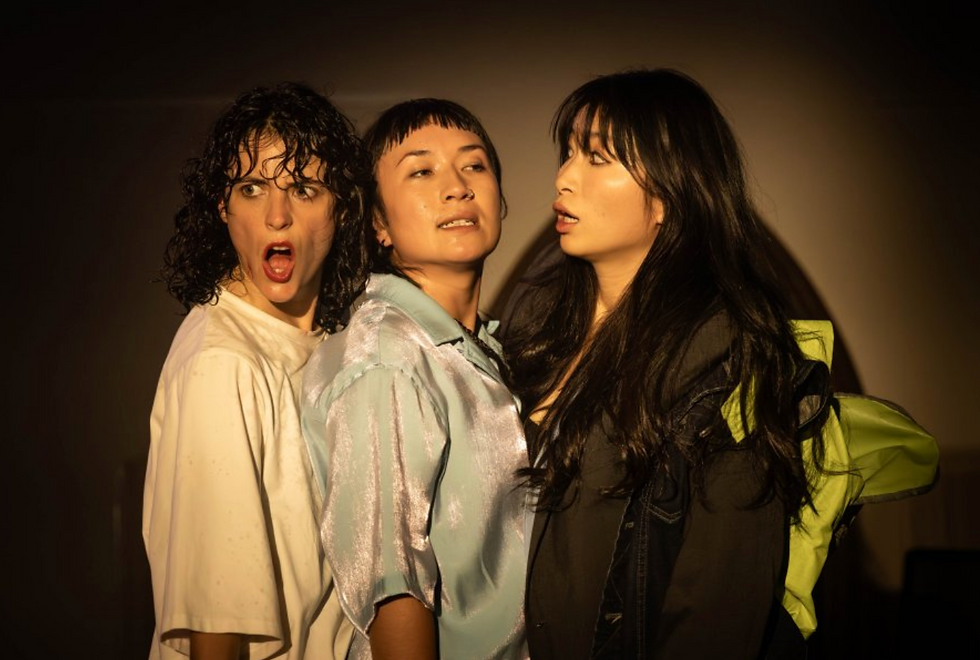Review: Sunday in the Park with George at Lawler Theatre Southbank
- Theatre Travels

- Aug 24, 2019
- 4 min read
By Alice Mooney
This is an intimate, colourful and quaint portrayal of painter George Seurat (Nick Simpson-Deeks) and his struggle to balance the unpredictability of real-life people and emotions with his desire to control and compose them within a single painting. First performed in 1984, Stephen Sondheim and James Lapine’s Pulitzer prize winning musical centres the action around artist George Seurat’s most famous work, A Sunday afternoon on the island of La Grande Jatte. It begins with the artist sketching his composition which synchronises with the introduction of the musical narrative. Characters materialise onto the stage and real-life obstacles start to disrupt the artistic process. We are introduced to George's mistress and muse named Dot (Vidya Makan), a charming reference to his rebellious pointillist brushwork. We meet George’s mother (Jackie Rees), who in her old age foreshadows her sons struggle to make sense of the changing world around her as her health deteriorates. Two giggly young women gossip in the scene and George receives unsolicited critique from an incorrigible acquaintance. The characters mingle and mill about in the background at first, then become more potent and disconcerted as George sinks ever deeper into the fantasy of his painting and loses touch with his immediate reality. The show progresses as the people from the park quickly meld into caricatures which play out fantastical scandals all under the close watch of George. As the painting comes to fruition it becomes clear that George is unable to achieve both artistic perfection and maintain his present relationships. Dot, after giving birth to his daughter, Marie, leaves for America whereby we are transported into the second act.
The second act brings with it one hundred years of progress and with that, a much-needed boost of energy with a change to the retro 80’s and all of the fashion and flair that defines it. We meet 19th Century George’s distant descendant, a modern George exhibiting in the post-modernist era. Although a century has passed, modern George still battles with all the same obsessive need for understanding and approval like that of his predecessor. His grandmother, the now elderly Marie, carries with her a small journal which belonged to her mother Dot and her family’s ensuing connection to the now famous landscape; A Sunday Afternoon on the Island of La Grande Jatte. Modern George, whose interest in the 19th century landscape is purely technical, maintains doubt in the alleged connection.
In the first act, Jackie Dees brings complexity and heart to the character of George’s mother. Her emotional duet with Simpson-Deeks is unexpected and greatly received as the audience is hit by the characters melancholy surrounding her declining health and awareness. Simpson-Deeks and Vidya Makan share fantastic chemistry as George and Dot. Though perhaps more friendly in affection than flirtatious, their energy bounces from one another across the stage. Makan, however steps it up in the second act as wheelchair bound Marie where, in the twilight light of her years, she maintains all the animation and vivacity of her mother, Dot, which parallels against the painting’s ageing success.
The backdrop on the stage shows Georges sketches and sporadic progress of the composition. It displays Georges perspective of the scene as well as the small and insignificant insecurities he fussed over. I would have liked to see this technical element play a greater role as I found myself constantly looking to the screen for reference to George’s progress when it remained stagnant. The costumes were a significant highlight. There was great care in devoting the brightest colours to reflect the personality of that character. Pairs of complimentary colours; red and purple, navy and gold, green and crimson are subtly dotted to emphasise the crossover between the figures in the real life and their representation in the pointillist painting.
However, the gradual separation between George and his lover proved a little stale given the fact that there was little show of any deep affection and resounding love to begin with. As a result, it felt difficult to sympathise with their suffering in song when Dot moves on and George becomes ever more enveloped in his painting. Directors Dean Drieberg and Sonya Suares instead, focus on a theme of maternal foundation. The relationships between both mother/grandmother and son are penetrative and remain as the strongest link that brings George out of his work to face the uncontrollable realities of his life. On stage, the wayward artist orbits around both mother and grandmother who nearly always remain seated. I can only credit directors Dean Drieberg and Sonya Suares for bringing together a crisp and captivating interpretation of what is essentially a constricting script to undertake.
Sunday in the Park with George addresses our desire to romanticise art into a state of perfection that removes us from the human experience. It forces audiences to reconsider art and representation with a greater depth, empathy and an eye for meaning over the aesthetic. Desires of perfection in the art of representation remain strong as I am reminded of the selfie culture and influencers that bombard our social media pages today. While the technologies of the day feel like a distraction or dilution from the skill of more traditional methods, Sunday in the Park with George reminds us of the artful realities of life, which cannot be contained or filtered in a single frame yet are always accessible and full of meaning.
Photo Credit: Jodie Hutchinson
All opinions and thoughts expressed within reviews on Theatre Travels are those of the writer and not of the company at large.
















